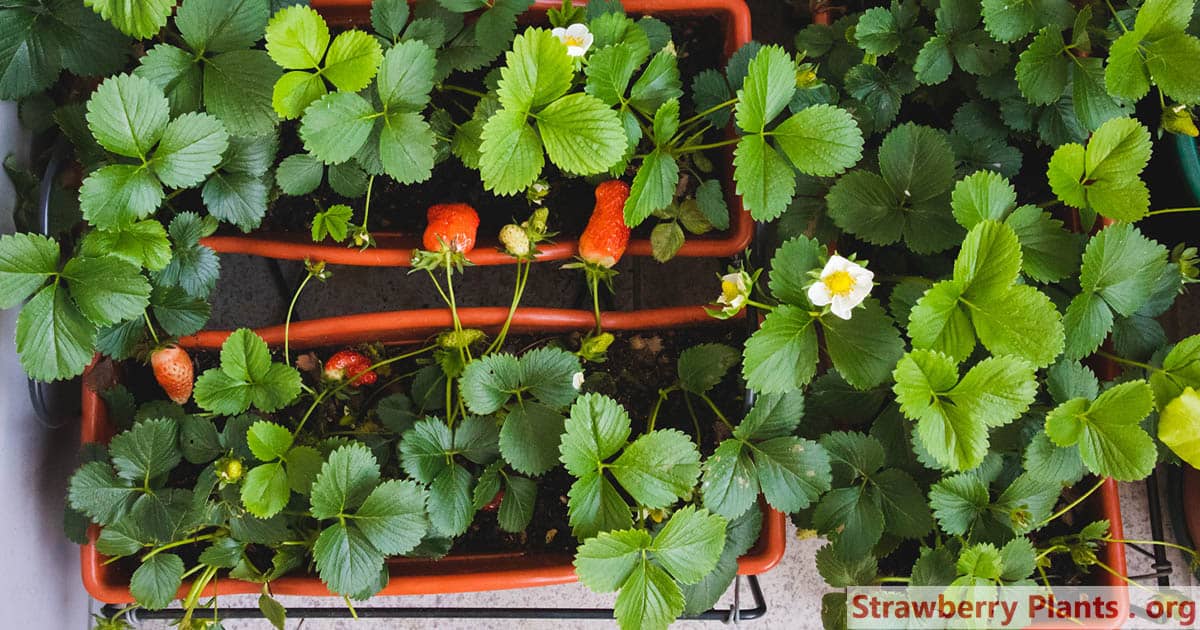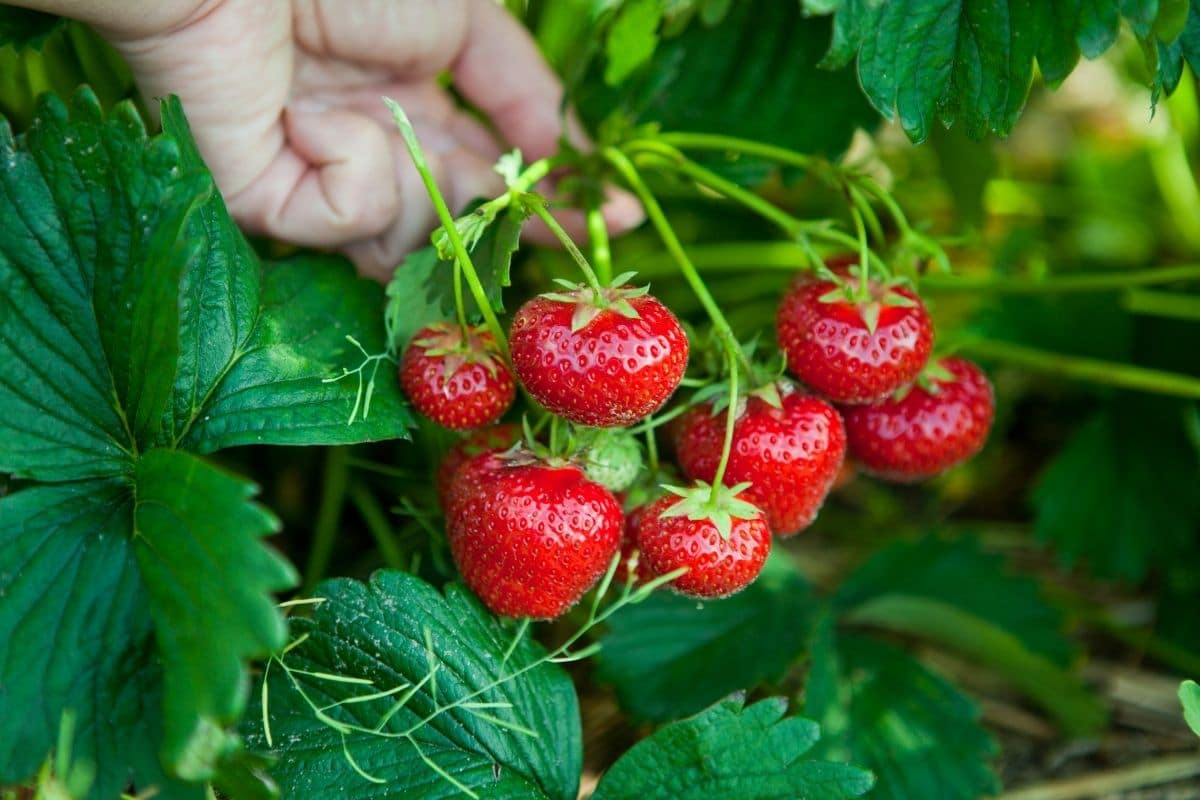Listen up fellow gardeners! I’ve got some exciting news for those of you with shady yards who’ve been dreaming of growing your own strawberries. The short answer is YES – strawberries can grow in shade but there’s a catch. Let me break it down for you in this complete guide.
The Truth About Strawberries and Shade
I’m not going to sugarcoat it: most types of strawberries love being in the sun. You might not be able to use that spot if it’s in the shade, though. Here’s what you need to know .
- Minimum sunlight needed: At least 5 hours of direct sun daily for decent fruit
- Absolute minimum: 4 hours of sun for some varieties
- Best results: 8+ hours of sun (but we’re focusing on shade-tolerant options!)
Best Strawberry Varieties for Shade
There are different kinds of strawberries that do better or worse in shade. Here are your best bets .
Alpine Strawberries
These little champions are your go-to option for shade. If you want to grow strawberries, these are the ones to get. They can handle those tricky shady spots where other strawberries would be afraid to go.
Key features:
- Don’t produce runners (less maintenance – yay!)
- Fruit continuously throughout growing season
- Smaller berries but absolutely delicious
- Perfect for USDA zones 3-10
Top Shade-Tolerant Varieties:
-
Alexandria
- Most recommended for primarily shady areas
- Super adaptable
- Reliable producer
-
Yellow Wonder
- Unique yellow fruits
- Handles partial shade well
- Interesting flavor profile
What Happens When Strawberries Get Less Sun?
Let me tell ya what I’ve learned about shade-grown strawberries:
The Good:
- Plants develop larger, darker green leaves
- Less water needed
- Lower maintenance overall
- Can still produce fruit!
The Trade-offs:
- Smaller berries (about 50% smaller than sun-grown)
- More tart flavor
- Less sugar content
- Fewer berries overall
Growing Tips for Success
Soil Preparation
Your shady strawbs need some extra love:
- Rich, well-draining soil
- Lots of organic matter
- Good aeration
- Moisture-retentive but not waterlogged
Maintenance Tips
- Keep soil consistently moist
- Remove weeds promptly (they’ll compete for limited light)
- Watch for signs of overwatering
- Fertilize regularly but don’t overdo it
Real Talk: Managing Expectations
Listen, I gotta be honest with y’all – if you’re growing strawberries in shade, you won’t get the same results as those growing in full sun. But that’s okay! Here’s what to expect:
- Smaller harvests
- More compact plants
- Different flavor profile
- Longer time to ripening
Alternative Uses for Shade-Grown Strawberries
Don’t just think about fruit production! Shade-grown strawberries can be awesome for:
- Ground cover
- Wildlife habitat
- Ornamental value
- Natural erosion control
Troubleshooting Common Issues
Sometimes things don’t go as planned. Here are some common problems and solutions:
Problem: Super Small Fruits
- Solution: Ensure at least 4-5 hours of sun
- Try redirecting light with reflective surfaces
- Consider container growing for mobility
Problem: No Fruits
- Solution: Check pollination
- Verify light hours
- Review fertilization schedule
My Personal Experience
Let me tell you, I’ve been growing strawberries in my partly shaded backyard for years, and it’s totally doable! Sure, I don’t get as many strawberries as my neighbor does in her sunny plot, but my alpine strawberries give me enough sweet little berries to last all season.
Can strawberries grow in shade? You betcha! While they might not be as productive as their sun-loving cousins, with the right varieties and proper care, you can definitely grow strawberries in shadier spots. Just remember to:
- Choose shade-tolerant varieties
- Provide at least 4-5 hours of sun
- Maintain good soil conditions
- Adjust your expectations
So go ahead and give it a try! Your shady garden might just surprise you with some sweet little treats. And hey, if you’ve got any questions or wanna share your own shady strawberry success stories, drop a comment below. I’d love to hear from ya!
Happy gardening, folks!
How Much Shade Can Strawberries Tolerate?
The minimum amount of direct sun that strawberries need every day to bear large, tasty fruit is about five hours a day. It’s possible for strawberry flowers to bloom in even less light, but the strawberries they make will be small, wet, and sour.
Dr. Hyo Gil Choi at Kongju University in South Korea studied the light requirements of strawberries grown in the winter in greenhouses with different amounts of sun exposure. He left some strawberry plants completely shaded by curtains until 10 o’clock every morning, some strawberry plants completely shaded by curtains until noon, and some strawberry plants completely shaded by curtains until 2 o’clock in the afternoon. He also had strawberry plants he allowed to receive full sunshine.
In this part of Korea, the sun rises around 7 a.m. and goes down before 5 p.m. This means that the strawberry plants received 10, seven, five, or three hours of sun every day. Any amount of sunlight, even three hours a day, is better for the strawberry plants than none at all.
Dr. Choi discovered that the strawberry plants that received the least light made the most chlorophyll. They had unusually dark-green leaves. It was as if they were trying extra hard to use all the sunlight they received.
The Korean researcher also discovered that there were huge differences in the size and sugar content between the berries grown under different light conditions, but no difference in acidity. The strawberries grown with just three hours of sun every day were small and tart. The strawberries grown in full sunlight were bigger and had greater sugar content.
Here is a summary of his results:
- Strawberry plants that got full sun were about 50% bigger than strawberry plants that got little light.
- Strawberry plants that got the most shade had four times as many “tiny” strawberries (less than 10 grams, or 1/3 of an ounce) as plants that got full sun.
- Strawberry plants that got full sun had up to 50% more fructose, glucose, and sucrose sugars than strawberry plants that got the least shade.
- Strawberry plants that were in the shade had the same amount of acetic acid (the acid in vinegar) as strawberry plants that were in the sun. They had strawberry tartness without the full strawberry sweetness.
Dr. Choi’s findings confirm what a lot of home gardeners already know. Strawberries grown in shade are small and tart. That doesn’t mean that you would never want to grow them, just that you should expect differences in size and flavor.

Can Strawberries Grow in Total Shade?
It’s not hard to find photos and videos of strawberry plants growing in total shade under fruit trees. Free of weed competition, planted in well-drained, heavily fertilized soil, strawberries can put on dense, dark-green foliage even when they don’t get any direct sunlight at all.
Strawberries grown in complete shade often have unusually large leaves. They even made a few flowers. But you are unlikely to find many examples of strawberries actually putting on fruit until the sun is sufficiently high in the sky that even plants growing under trees get several hours of sunlight every day.

On the other hand, strawberry plants growing in greenhouses in sunny desert locations like Arizona and the interior of Southern California actually need some shade every day to protect plants from sunburn. In these locations, it may be impossible to keep strawberry plants going through the entire summer. Around the first week of summer, light and heat prove to be too much for these strawberry plants.
One of the secrets of success for growing strawberries, not just beautiful foliage, is to strike a healthy balance between sun and shade.
Growing Strawberries in Shade (Amazing Growth)
FAQ
Can strawberries grow in shade?
It is true that strawberries need at least eight hours of sunlight to produce, so what a shaded yard needs aren’t the cultivated strawberry we’ve become accustomed to. Instead, you are looking for a shade tolerant strawberry which will be a variety of wild strawberry. Can Lavender Grow In Shade?.
How do you grow strawberries in a shade?
Stick your finger 1-2 inches below the surface and if it is dry, add some more water to the soil. Avoid keeping the crown or the central stem of the strawberry too wet otherwise it can rot. Shade grown strawberries will keep moist for longer and channel more water into growing the strawberry fruit. My strawberries growing well in shade.
What is a partially shaded strawberry plant?
Partially shaded areas: These are places where strawberries get filtered sunlight for part of the day but not much direct sunlight. A spot with some shade gets less than 6 hours of sunlight a day but at least 4 hours of sunlight a day, usually in the morning when the light and heat are not as strong.
Do strawberry plants need shade every day?
On the other hand, strawberry plants grown in greenhouses in sunny desert places like Arizona and the central part of Southern California need shade every day to keep them from getting sunburned. In these locations, it may be impossible to keep strawberry plants going through the entire summer.
Do strawberries grow bigger if they get full sun?
Here is a summary of his results: Strawberry plants that got full sun were about 50% bigger than strawberry plants that got little light. Strawberry plants that got the most shade had four times as many “tiny” strawberries (less than 10 grams, or 1/3 of an ounce) as plants that got full sun.
What are wild strawberries for shade?
Wild strawberries are the type of strawberries for shade. When we are talking wild strawberry for shade, we are speaking of alpine strawberries. Alpine strawberries grow wild along the perimeters of forests in Europe, North and South America, northern Asia, and Africa. Alpine strawberries (Fragaria vesca) for shade do not send out runners.
